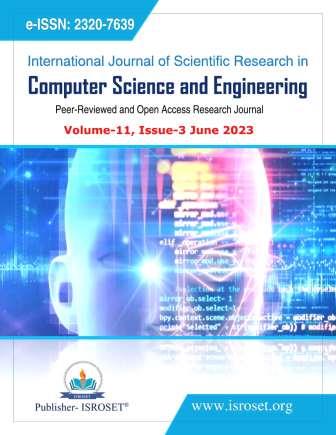Data Encryption Technique based on Enhancement of Blowfish Algorithm in Comparison of DES & DCT Methods
Keywords:
DES, DCT, AES, LSB, BlowfishAbstract
Cryptographic methods or techniques are mathematical operations used to encrypt plaintext into cipher text and vice versa. The improved security of the encrypted message; the algorithm can be improved based on its complexity and the secrecy of the key used to encrypt and decrypt the message. Cryptosystems are a combination of cryptographic based algorithms, keys, and protocols that work together to provide secure communication. The strength of the encrypted data relies by improving the security of the cryptographic algorithm and how the key is secured during transmission over a network. The cryptographic algorithm should be strong enough for preventing the unauthorized access by keeping the key as secret to ensure that only the authorized people are able to access the encrypted data. Encryption of the data is a crucial step in securing data. Implementing the Blowfish algorithm and comparing its performance with the DES algorithm can provide insights into the strengths and weaknesses of both algorithms. By giving the data and key as input to the encryption block, the Blowfish algorithm can encrypt the data to protect its confidentiality. The comparison with DCT can also highlight the trade-offs between performance, security, and implementation complexity. The research in this paper has focused on the enhancement of Blowfish algorithm for securing the content in plaintext and file message using encryption techniques. The performance for Blowfish algorithm can be intensified by minimizing the rounds in reference with increasing the block length of fixed length by using the transformation model.
References
David A. Huffman, ―A Method for the Construction of Minimum - Redundancy Codes‖, Proceedings of the I.R.E., September, pp.1098–1102, 1952.
M. Kharrazi, H. T. Sencar, N. Memon, Image Steganography: Concepts and Practice, Lecture Note Series, Institute for Mathematical sciences, National University of Singapore, 2004.
W. Pennebaker and J. Mitchell. ―JPEG STILL IMAGE DATA COMPRESSION STANDARD". van Nostrand Reinhold, 1993.
L. Marvel ―Image Steganography for Hidden Communication". Ph.D. Dissertation, Univ. of Delaware, Dept of EE, 1999.
Robert T. McKeon ―Strange Fourier Steganography in Movies‖, Proceedings of IEEE EIT 2007.
R. Gonzalez and R. Woods, ―Digital Image Processing‖, Sec. Edition. Pp.373-374.
S. Mallat, ―A theory for multiresolution signal decomposition: the wavelet representation‖, IEEE Pattern Anal. and Machine Intell., Vol.11, No.7, pp.674-693, 1989.
Marcelloni, Francesco, and Massimo Vecchio. "A simple algorithm for data compression in wireless sensor networks." Communications Letters, IEEE, Vol.12, no.6, pp.411-413, 2008.
Srisooksai, Tossaporn, Kamol Kaemarungsi, Poonlap Lamsrichan, and Kiyomichi Araki. "EnergyEfficient Data Compression in Clustered Wireless Sensor Networks using Adaptive Arithmetic Coding with Low Updating Cost."International Journal of Information and Electronics Engineering Vol.1, no.1, pp.85-93, 2011.
Xi Xu et al. [2012]: Image Compression Using Radon Transform With DCT : Performance Analysis. International Journal of Scientific Engineering and Technology. Vol.2, Issue.8, pp.759- 765, 2012.
Dong-U Lee et al. [2009]: Precision-Aware Self-Quantizing Hardware Architectures for the Discrete Wavelet Transform, IEEE Vol.21, 2009.
Dolfus, Kirsten, and Torsten Braun. "An evaluation of compression schemes for wireless networks." In Ultra Modern Telecommunications and Control Systems and Workshops (ICUMT), 2010 International Congress on, IEEE, pp.1183-1188. 2010.
A Survey on Data Compression in Wireless Sensor Network Naoto Kimura and Shahram Latifi Electrical and Computer Engineering, University of Nevada, Las Vegas{naoto, latifi}@egr.unlv.edu International Conference on Information Technology: Coding and Computing (ITCC’05) IEEE 2000.
Medeiros, Henry Ponti, Marcos Costa Maciel, Richard Demo Souza, and Marcelo Eduardo Pellenz. "Lightweight Data Compression in Wireless Sensor Networks Using Huffman Coding." International Journal of Distributed Sensor Networks 2014.
Liang, Yao. "Efficient temporal compression in wireless sensor networks." InLocal Computer Networks (LCN), 2011 IEEE 36th Conference on, IEEE, pp.466-474. 2011.
Marcelloni, Francesco, and Massimo Vecchio. "A simple algorithm for data compression in wireless sensor networks." Communications Letters, IEEE Vol.12, Issue.6, pp.411-413, 2008.
Paar, Christof. "Applied cryptography and data security." Lecture Notes), Ruhr-Universität Bochum (http://www. crypto. ruhr-uni-bochum. de), 2000.
Hager, Creighton TR, Scott F. Midkiff, Jung-Min Park, and Thomas L. Martin. "Performance and energy efficiency of block ciphers in personal digital assistants." In Pervasive Computing and Communications, 2005. PerCom 2005. Third IEEE International Conference on, IEEE, pp.127-136, 2005.
Agarwal, Navita, and Himanshu Sharma. "An Efficient Pixel-shuffling Based Approach to Simultaneously Perform Image Compression, Encryption and Steganography." International Journal of Computer Science and Mobile Computing (IJCSMC) 2, no. 5, pp.376-385, 2013.
M. P. R. Kamble, M. P. S. Waghamode, M. V. S. Gaikwad, and M. G. B. Hogade, “Steganography techniques: A review,” International Journal of Engineering, Vol.2, no. 10, 2013.
H. Inoue, A. Miyazaki, and T. Katsura, “An image watermarking method based on the wavelet transform,” in Proceedings 1999 International Conference on Image Processing (Cat. 99CH36348), IEEE, Vol.1, pp.296–300, 1999.
K. Raja, K. Kumar, S. Kumar, M. Lakshmi, H. Preeti, K. Venugopal, and L. M. Patnaik, “Genetic algorithm based steganography using wavelets,” in International Conference on Information Systems Security. Springer, pp. 51–63, 2007.
C.-K. Chan and L.-M. Cheng, “Hiding data in images by simple lsb substitution,” Pattern recognition, Vol.37, no.3, pp.469–474, 2004.
R. El Safy, H. Zayed, and A. El Dessouki, “An adaptive steganographic technique based on integer wavelet transform,” in 2009 International Conference on Networking and Media Convergence. IEEE, pp.111–117, 2009.
A. M. Fard, M.-R. Akbarzadeh-T, and F. Varasteh-A, “A new genetic algorithm approach for secure jpeg steganography,” in 2006 IEEE International Conference on Engineering of Intelligent Systems. IEEE, pp.1–6, 2006.
D. R. ElShafie, N. Kharma, and R. Ward, “Parameter optimization of an embedded watermark using a genetic algorithm,” in 2008 3rd International Symposium on Communications, Control and Signal Processing. IEEE, pp.1263–1267, 2008.
Downloads
Published
How to Cite
Issue
Section
License

This work is licensed under a Creative Commons Attribution 4.0 International License.
Authors contributing to this journal agree to publish their articles under the Creative Commons Attribution 4.0 International License, allowing third parties to share their work (copy, distribute, transmit) and to adapt it, under the condition that the authors are given credit and that in the event of reuse or distribution, the terms of this license are made clear.







